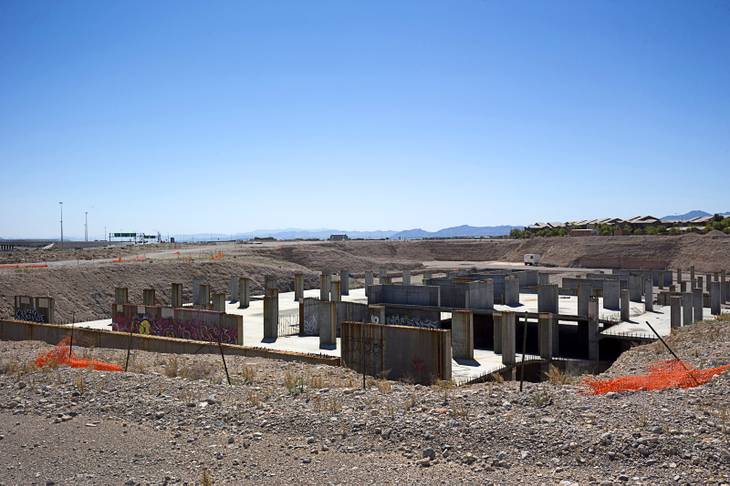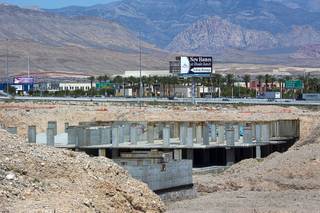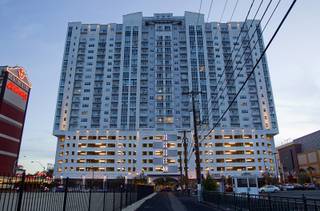Southern Nevada’s once-pummeled construction industry has bounced back from the depths of the recession, with builders putting up housing tracts, apartment complexes, warehouses and retail plazas.
But one type of project, a poster child for Las Vegas’ real estate craze last decade, is missing from local construction sites: residential towers.
“Nobody in their right mind would build another high-rise here right now,” Keller Williams Realty agent Truman Fleming said.
Real estate pros don’t view the lack of high-rise development as a bad thing. Condo prices aren’t as high as they used to be, crimping developers’ revenue and ability to book a profit and repay construction loans. Banks, meanwhile, collapsed nationwide during the recession under bad real estate deals, and they aren’t nearly as willing to finance a tower anymore.
Sam Cherry developed two condo towers in downtown Las Vegas — Soho Lofts and Newport Lofts — during the housing bubble, when the valley was awash in easy money and home prices were soaring. But today, he says, there’s no way he could build them amid the market’s lower sales prices and lenders’ skittishness.
“There’s not even a chance of selling a new building,” he said.
Even if investors wanted to build a high-rise rental tower, they couldn’t fetch the prices needed to make a profit, according to Cherry.
Las Vegas consultant and analyst John Restrepo said a residential high-rise could be built in the next decade or so on the Strip, as part of a mixed-use project. But it seems highly unlikely that one would be built in the suburbs anytime soon, as was planned during the boom years.
With its sprawling subdivisions of single-family homes, Las Vegas is “not a high-rise market,” unlike big, densely packed cities such as New York.
“We’re not there yet as a community,” said Restrepo, founder of RCG Economics. “Will we ever get there? Not in our lifetimes.”
Elite Realty broker June Stark said investors weren’t building towers because of “basic economics.” To make a profit, for instance, they would have to sell condos at prices they largely can’t command nowadays.
“Our market’s not there yet,” she said.
Stark also noted that towers’ homeowners association dues — which can easily cost more than $1,000 per month — typically were out of reach for local residents.
Most high-rise buyers, at least in properties on or near the Strip, are wealthy out-of-towners who often rent the units out or use them as crash pads for Las Vegas getaways. But that buyer pool is “relatively limited,” and local residents, many of whom work in casinos or other tourism-related jobs, often can’t afford the sales prices or HOA dues, Restrepo said.
Buyers picked up 336 high-rise units this year through mid-June, compared with 12,300 single-family homes through May, according to the Greater Las Vegas Association of Realtors’ resale-heavy listing service.
For the same price or less, homebuyers often can get more space and a larger home in the suburbs than in a tower.
In late January, for instance, a married couple bought a one-bedroom, 963-square-foot condo in the Ogden, a downtown high-rise, for $245,900. The next day, a buyer picked up a two-story, four-bedroom, 2,220-square-foot house in the south valley for $245,000, Clark County records show.
“You just get more bang for your buck with a house,” said Fleming, of Keller Williams.
Lorne Polger, co-founder of San Diego-based Pathfinder Partners, which last year bought 64 units in Sky Las Vegas, a north Strip condo tower, figures there won’t be a high-rise built in Las Vegas “for an extended period” — perhaps not until the 2020s.
He, too, cited the reason as “basic economics,” as the market’s current sales prices are too low.
Investors built towers around the country during the housing bubble, he noted, and lenders “got burned pretty hard” during the recession.
Banks “are still pretty skittish” about high-rise development, Polger said, even years after the market crashed.
Along with Soho and Newport, Cherry had also started work on a planned tower at Third Street and Gass Avenue downtown. He said he did some site work and pre-sold half the units, but the market was already sliding, so he halted the project and sold the land.
He also noted that Corus Bank was going to finance the project. The Chicago-based lender had bankrolled other Las Vegas condo towers, including Soho and Newport, but was shut down in 2009.
If he had kept building, Cherry said, the project would have ended up like the failed, blue-tinted hotel tower that still stands, partially built, on the north Strip.
“It would have been the Fontainebleau of downtown,” he said.
•••
High-rise housing wasn’t new to Las Vegas last decade. Regency Towers, apparently the first high-rise condo complex in town, opened in the 1970s at the Las Vegas Country Club.
But with easy credit sloshing around for developers and homebuyers alike, Las Vegas’ fast growth turned white-hot. Housing tracts, condo buildings, office parks, shopping centers and other projects were built valley-wide at a rapid pace. Property values soared, investors flipped homes — and would-be developers laid out plans for dozens of high-rises.
Supporters called it the “Manhattanization” of Las Vegas.
“Have you ever thought about what it would be like to live in Manhattan?” Richard Lee, then-public relations director at First American Title Co. of Nevada, and a vocal proponent of the high-rise boom, told a business conference in early 2004.
Fifty residential and commercial high-rise projects, comprising 82 towers, had been announced or were on the drawing board in the Las Vegas area by summer 2004, the Las Vegas Sun reported. The tally included 44 condo towers.
“We’re talking to experienced people from Chicago, New York and London,” Lee said at the time. “They look at this market and say it is just ripe, it is perfect, and it is next.”
Celebrities such as Leonardo DiCaprio, Jessica Simpson and Tobey Maguire reportedly bought high-rise units here, and developers held lavish sales parties and doled out pricey gifts. Stark, of Elite Realty, said she went to a party with caged tigers, got a monogrammed bathrobe at another function, and saw half-dressed people dripping with chocolate at yet another.
“The more (gifts) we got, the more we knew the project wouldn’t get off the ground,” she said.
•••
It didn’t take long for people to notice that planned projects far outweighed what was actually being constructed.
“All we’ve got to go on right now is what the sales managers are telling us,” housing analyst Larry Murphy said in spring 2004. “Other than (a few projects), none of them have been built.”
Plans for more towers kept coming, but by 2006 some projects had been canceled. Eventually, when the bubble burst and the recession clobbered Las Vegas harder than almost any other metro area, the high-rise market collapsed with the valley’s economy.
Condo towers that got built were hit with foreclosures, litigation and plunging sales totals, but overall, most planned high-rises never materialized.
“It’s been an interesting few years,” Lee told the Las Vegas Review-Journal in 2010. “How things changed. We had the fastest-growing city in the nation. Now we’re No. 1 in foreclosures.”
The carcass of one abandoned high-rise project still sits in southwest Las Vegas: Spanish View Tower. Planned as three 18-story towers during the bubble years, the project site today is little more than a giant, fenced-off hole in the ground with a partially built parking garage.
In early 2006, developer Rodney Yanke said in a news release that the 15-acre project at Buffalo Drive and the 215 Beltway would “surpass anything Las Vegas has seen” and be “the foundation for high-rise living” in the Western U.S.
The news release noted it would take almost 437 million 1-ounce jars of caviar to equal the 27.3 million pounds of cement that workers poured for the foundation, the completion of which was “a clear signal” that the project was “well on its way to reality.”
But construction stopped that year, and creditors filed papers in 2007 to force the project into bankruptcy.
In fall 2007, creditors alleged in a court filing that Yanke — whose other ventures included DWG International, a multi-level marketing company that sells “waterless” car-wash products — used project money for his 7,200-square-foot house in Las Vegas. He also used project funds for luxury cars and to pay for a captain for his 55-foot boat, called “Squirt the Dirt,” in Tampa, Fla., the filing claimed.
Yanke had “no experience building any kind of high-rise condominium project,” and when his promises of imminent project financing fell through, he always blamed some kind of “massive fraud” that had been perpetrated against him, the filing claimed.
Yanke could not be reached for comment for this story.
Real estate broker and investor Jack Woodcock — also a Spanish View lender — acquired the site through foreclosure in 2012. He’s trying to sell it for $18.9 million.
Woodcock said a Chinese development company was under contract the past two years to buy the property, but the deal recently fell through.
Some $30 million worth of work was put into the site a decade ago, he said, and if built, the towers could lure people from single-family houses, as project plans have called for large condos. Yanke planned to offer units ranging from 1,835 to 9,500 square feet.
“The demand for this kind of project still exists,” Woodcock said.
Stark, for one, said high-rises were bound to get built during the housing boom amid Las Vegas’ then-soaring population growth and skyrocketing land prices. And now, with the supply of developable land shrinking, she said, towers could rise again.
“Eventually,” she said, “the vertical growth will be inevitable.”


